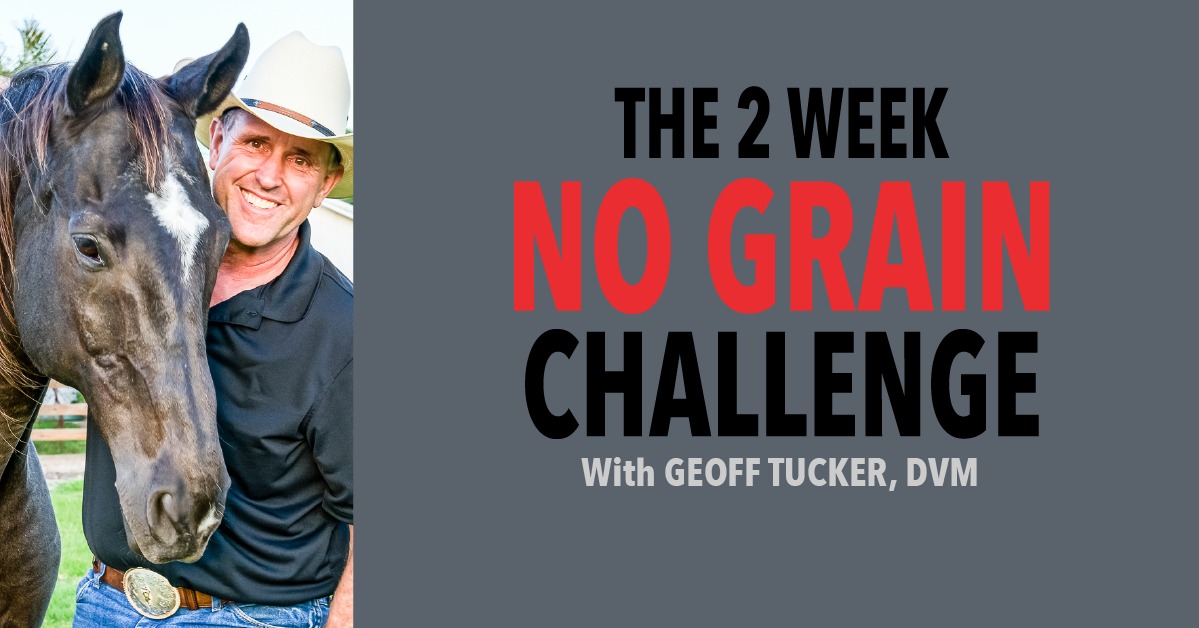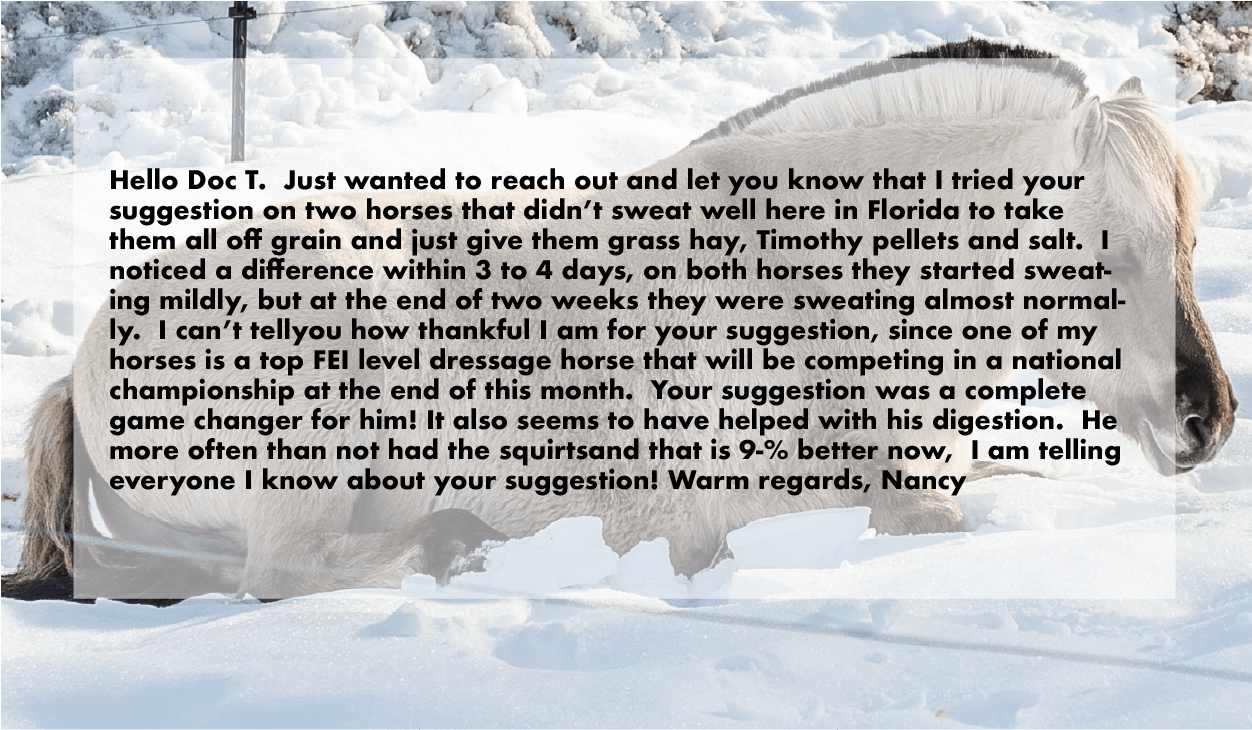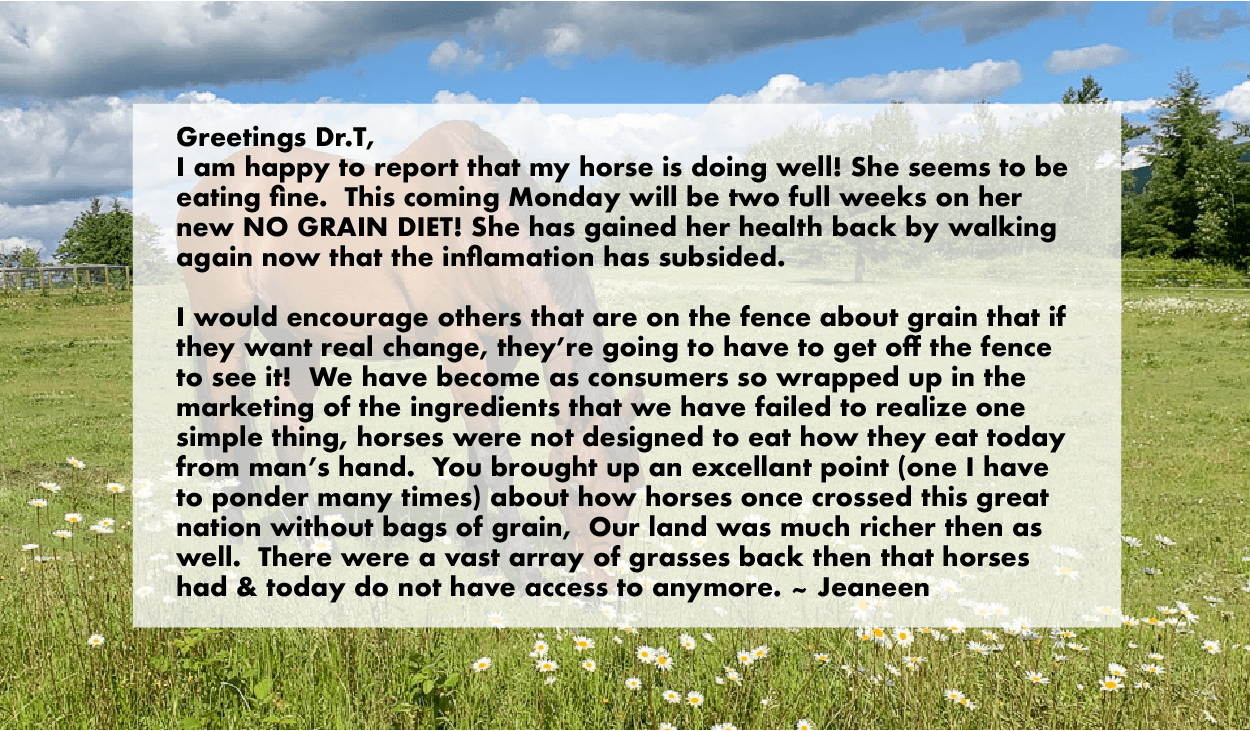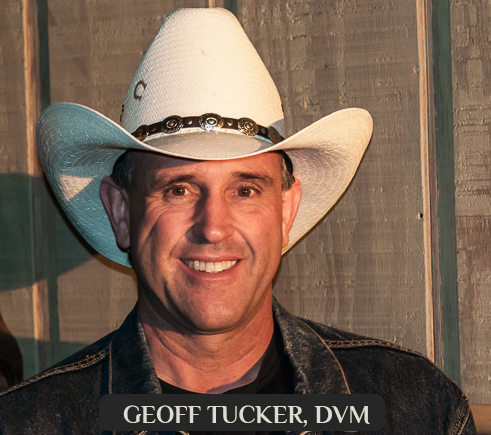What is the “No Grain Challenge”?
- Unwanted weight gain or loss
- Loss of top line
- Poor hoof condition
- Poor hair coat
- Bad behavior, uneasy
- Can’t tighten the girth
- Can’t brush the hair
- Objects to trot or other gaits
- Bad shipper
- Laminitis
- Metabolic syndrome
- Cushing’s (PPID)
- Anhidrosis (non-sweating)
- Poor exercise recovery
- Poor work ethic
- An unwilling partner
Let me tell you how all of the issues listed above are effected by grains, or in another word SUGAR, in this short video:.

The Two Week No Grain Challenge
- First: Get a calendar or open an app and circle TODAY’S date. This will be your start date for the challenge. Photograph or take a video of your horse and document his/her behavior and body composition IN DETAIL.
- Second: DO NOT feed any grain or sugar including natural sugars, treats and supplements with sugar ingredients such as: corn, wheat, oats, carrots, apples, molasses, honey, wheat mids or middlings, seeds, hulls or byproducts. If your horse needs to take a supplement for medical reasons find one without sugar ingredients.
- Third: DO FEED hay (grass or grass plus a legume like alfalfa), pasture, water, mined salt (salt from a mine such as Himalayan or Redmond, not with a sugar binder!).
- Fourth: After 2 weeks send me your diary. If shooting video remember to shoot it in landscape (turn the phone sideways) and give me permission to post it so others can learn from your experience with the Two Week No Grain Challenge. (All testimonies are written or expressed in their own words by their authors and are printed and posted with their permission).
Why Take the Two Week No Grain Challenge?
The core of the Two Week No Grain Challenge is the removal of all ingredients that may cause gut inflammation. The initial benefits of this are seen in about 3 to 4 days with most horses recovering from most inflammation in about 7 days and all horses in 2 weeks.
The 2 Week No Grain Challenge works and it costs nothing. In fact it will save you money! You do not add more hay or pasture. You do not feed treats, carrots, apples, mints, sugar or anything else. What you do is feed them the way they were created (ground plants +/- hay, mined salt and water). You also retrain yourself by learning about the foods horses should eat and how they fuel your horses.
If you find this too difficult for you to do, do it anyway. It is only 14 days and you can always go back. If you must treat your horses, give 1 (one) peanut in the shell. Peanuts are a legume (like alfalfa) and have no inflammatory sugar. Or a hay cube.
Start a journal with dates and observations. Judge for yourself. Did I mention this not only costs nothing but actually saves you money? Money you can use to become a member of The Horse’s Advocate and help spread this message to the world! Thanks in advance for trying the Two Week No Grain Challenge, becoming your Horse’s Advocate and Helping Horses Thrive In A Human World! Doc T

If your horse has ANY health issues please consult with your veterinarian before starting any diet change.
In very old horses (25 years and older) be careful because the chronic inflammation may cause them to actually lose weight (body fat revealing chronic lost muscle) without grain. In these cases get a medium chain triglyceride source of fat (more on this in this web site) to add energy that is non-inflammatory. (This is one exception where I would recommend a product such as CoolStance® which is shredded coconut meal as a great way to add non-inflammatory energy. When searching for a supplement for older horses be sure to avoid vegetable oils such as corn oil and soybean oil because they are inflammatory.)
To recap the Two Week No Grain Challenge:
1) Stop feeding sugar to reduce or eliminate insulin production and lectins to reduce or eliminate gut inflammation (grain, byproducts and all supplements including treats, carrots, sugar cubes, apples etc.).
2) Feed pasture and clean hay at about 1.5% of body weight (15 lb / 1000 lb horse or 7.5kg per 500 kg horse). Soak the hay if necessary at least 1 hour or more to reduce the sugar (starch, NSC) in the hay.
3) Have unlimited access to water and mined salt (Redmond or Himalayan).
I highly recommend starting a journal to record every possible observation and commit to this diet and chart for 2 weeks. If you feel capable, write a summary of your observations and send it to me with permission to post and help me get the message out.
Remember, if you don’t like the results you are getting you can always return to your original diet. No harm done.

Why Horses Should Not Be Fed Grain


